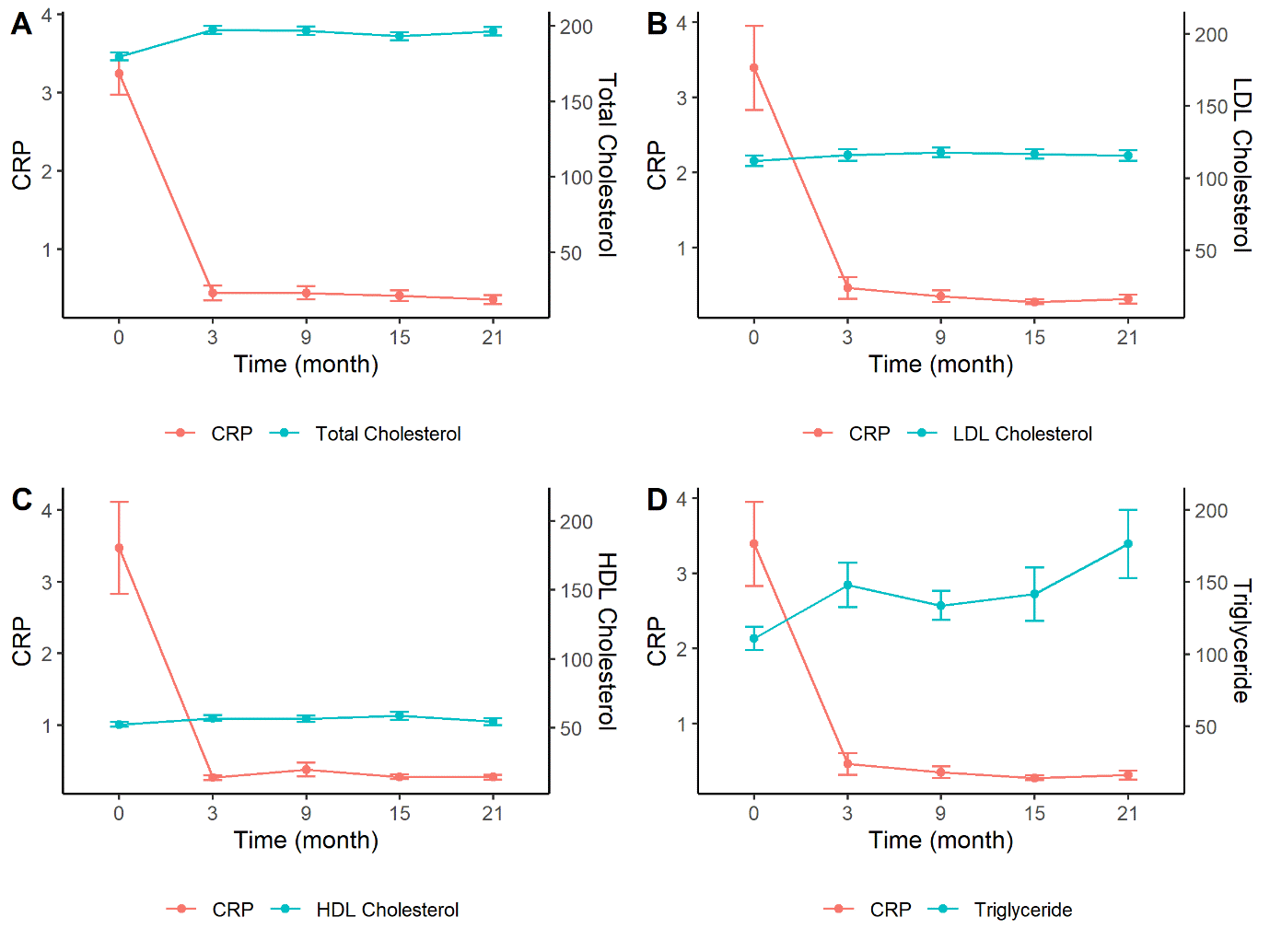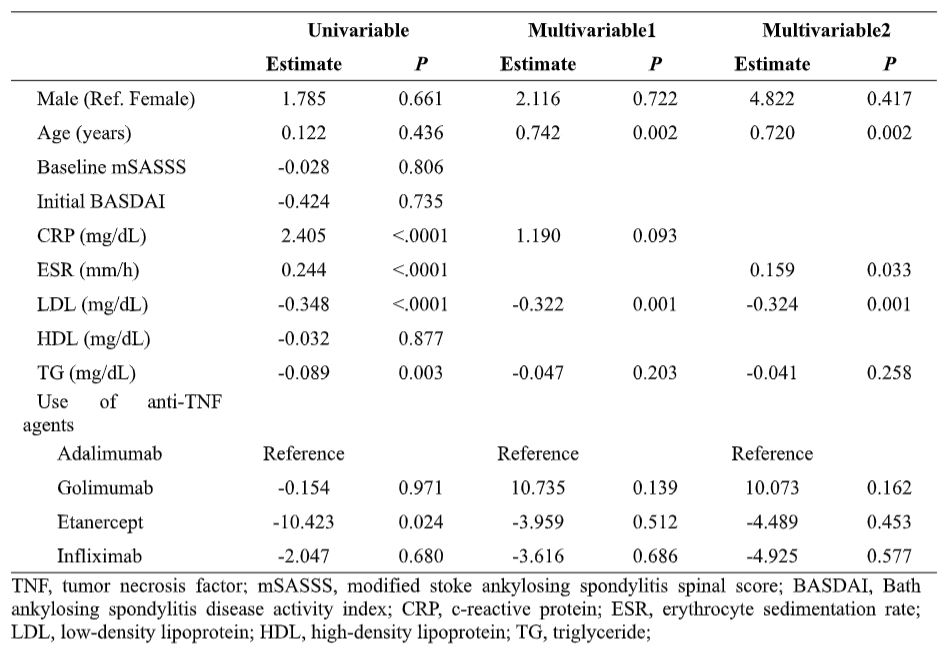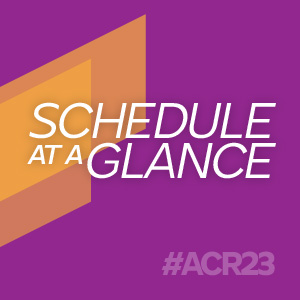Poster Session A
Spondyloarthritis (SpA) including psoriatic arthritis (PsA)
Session: (0510–0542) Spondyloarthritis Including Psoriatic Arthritis – Treatment Poster I: AxSpA
0531: Effects of Anti-tumor Necrosis Factor Treatment on Lipid Profiles in Patients with Ankylosing Spondylitis
Sunday, November 12, 2023
9:00 AM - 11:00 AM PT
Location: Poster Hall
- BN
Bora Nam, MD
Hanyang University Hospital for Rheumatic Diseases
Seoul, South KoreaDisclosure information not submitted.
Abstract Poster Presenter(s)
Inbeom Kwon1, bora nam2, Nayeon Choi3, Ji-Hui Shin2, Seunghun lee4 and Tae-Hwan Kim2, 1Department of Medicine, Hanyang University College of Medicine, Seoul, South Korea, 2Department of Rheumatology, Hanyang University Hospital for Rheumatic Diseases, Seoul, South Korea, 3Biostatistical Consulting and Research Lab, Medical Research Collaborating Center, Hanyang University, Seoul, South Korea, 4Hanyang University Hospital for Rheumatic Diseases, Seoul, South Korea
Background/Purpose: To investigate the effects of anti-tumor necrosis factor (anti-TNF) treatment on lipid profiles and identify risk factors for elevated total cholesterol (TC) after the treatment in ankylosing spondylitis (AS) patients.
Methods: A retrospective cohort study analyzed AS patients who received first-line anti-TNF treatment. Patients excluding underage and those on lipid-lowering agents, with at least nine months of follow-up were included. One-way ANOVA with repeated measures assessed the impact of anti-TNF inhibitors on disease activity and lipid profile (TC, Low-density lipoprotein [LDL], High-density lipoprotein [HDL], and triglycerides [TG]). Univariable and multivariable linear regression identified risk factors for elevated TC after 3 months of anti-TNF treatment.
Results: A total of 320 AS patients were enrolled (78.4% male, mean age 34.3 ± 10.8 years). TC and TG levels significantly increased particularly within the first 3 months of anti-TNF treatment, while LDL and HDL levels did not show significant changes. Changes in inflammatory markers and lipid particles (TC, LDL, TG) were strongly correlated over time, but HDL showed no significant correlation. Older age, higher baseline ESR, and lower baseline LDL levels were identified as risk factors for elevated TC after 3 months of anti-TNF treatment.
Conclusion: In AS patients, anti-TNF treatment has been found to increase lipid particles, potentially due to its anti-inflammatory effects. Future research should explore the clinical implications of dyslipidemia, particularly the occurrence of cardiovascular events, following anti-TNF treatment in AS patients.


I. Kwon: None; b. nam: None; N. Choi: None; J. Shin: None; S. lee: None; T. Kim: None.
Background/Purpose: To investigate the effects of anti-tumor necrosis factor (anti-TNF) treatment on lipid profiles and identify risk factors for elevated total cholesterol (TC) after the treatment in ankylosing spondylitis (AS) patients.
Methods: A retrospective cohort study analyzed AS patients who received first-line anti-TNF treatment. Patients excluding underage and those on lipid-lowering agents, with at least nine months of follow-up were included. One-way ANOVA with repeated measures assessed the impact of anti-TNF inhibitors on disease activity and lipid profile (TC, Low-density lipoprotein [LDL], High-density lipoprotein [HDL], and triglycerides [TG]). Univariable and multivariable linear regression identified risk factors for elevated TC after 3 months of anti-TNF treatment.
Results: A total of 320 AS patients were enrolled (78.4% male, mean age 34.3 ± 10.8 years). TC and TG levels significantly increased particularly within the first 3 months of anti-TNF treatment, while LDL and HDL levels did not show significant changes. Changes in inflammatory markers and lipid particles (TC, LDL, TG) were strongly correlated over time, but HDL showed no significant correlation. Older age, higher baseline ESR, and lower baseline LDL levels were identified as risk factors for elevated TC after 3 months of anti-TNF treatment.
Conclusion: In AS patients, anti-TNF treatment has been found to increase lipid particles, potentially due to its anti-inflammatory effects. Future research should explore the clinical implications of dyslipidemia, particularly the occurrence of cardiovascular events, following anti-TNF treatment in AS patients.

Figure 1. Changes in CRP and lipid particles after anti-TNF treatment.
CRP, c-reactive protein; TNF, tumor necrosis factor; HDL, high-density lipoprotein; LDL, low-density lipoprotein
CRP, c-reactive protein; TNF, tumor necrosis factor; HDL, high-density lipoprotein; LDL, low-density lipoprotein

Table 1. Risk factors for increased total cholesterol after 3 months of anti-tumor necrosis factor treatment
I. Kwon: None; b. nam: None; N. Choi: None; J. Shin: None; S. lee: None; T. Kim: None.



